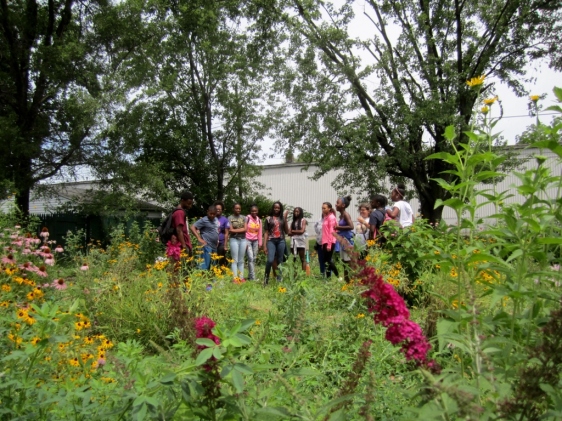Pollination Takes Many Forms
Recently a group of middle-schoolers from Edna Martin Christian Center‘s teen program came to Rivoli Park Labyrinth to find out what the pocket park is all about.

Walking the labyrinth
The park’s founder, Lisa Boyles, led the youth on a walk through the labyrinth, which is beautifully ringed by wildflowers this summer.

bumblebee
Sharp-eyed kids spotted some of the critters that make the park their home.

on the butterfly bush
As a certified wildlife habitat, the park provides food, cover, water, and nesting places for creeping and flying insects, toads, birds, and small mammals–and it is managed with sustainable gardening practices that are wildlife-friendly. (Lisa recently saw a falcon with a mouse in its talons, high in one of the trees.)

View from the butterfly bush
After the walk we talked about why it’s so important to support pollinators … without which it would be difficult to find actual food. When one of the boys said something about licking a flower, we picked red clover petals so everyone could try a sip of nectar. Tasty!
Soon the park will be designated a Monarch Waystation with the addition of milkweed, which monarch caterpillars eat. The kids got to sow milkweed seeds in small pots to take home and start their own monarch-friendly habitats.

Starting milkweed seed in peat pots.
Each teen also went home with a kit to make a butterfly feeder and instructions to make more nectar (1 part sugar to 1 part water, heated until sugar dissolves, then cooled).

A simple butterfly feeder.
Lisa notes that you can also attract butterflies with fruit. Butterflies are reported to love oranges, watermelons, mangoes, kiwis and apples. Fruit slices can be put on a plate with some water, or they can also be added to the sugar water feeders for added variety for the butterflies.
Pollination takes many forms. Insects pollinate flowers, while a woman like Lisa pollinates young lives by sharing a quiet space in the middle of the city’s hubbub.

A contemplative moment in the center of the labyrinth
All are welcome to explore Rivoli Park Labyrinth’s beauty, spread a blanket for a picnic, or walk the labyrinth anytime between dawn and dusk.
For more information on creating a certified wildlife habitat, see the National Wildlife Federation’s Gardening for Wildlife site.